The NVIDIA GeForce GTX 650 Ti Review, Feat. Gigabyte, Zotac, & EVGA
by Ryan Smith on October 9, 2012 9:00 AM ESTOverclocking: Power, Temperature, & Noise
Our final task is our look at the overclocking capabilities of our GTX 650 Ti cards.
Because the GTX 650 Ti is based on a lower clocked GK106 we should have more headroom to play with. Furthermore because GPU Boost is not present, and hence NVIDIA is not min-maxing GPU clockspeeds in the first place, there should be even more headroom to play with. For overclockers dissatisfied with overclocking in the world of GPU Boost, the GTX 650 Ti is going to be a return to old fashioned overclocking.
As an added benefit, because GPU Boost is not present NVIDIA is not operating these cards so close to their 1.175v limit. While it’s true the 1.175v limit is still in place, with the average shipping voltage being nearly 0.1v below that limit there’s some overvolting headroom to play with that GeForce 600 cards don’t typically get to experience.
| GeForce GTX 650 Ti Overclocking | ||||||
| Ref GTX 650 Ti | EVGA GTX 650 Ti SSC | Zotac GTX 650 Ti AMP | Gigabyte GTX 650 Ti OC | |||
| Shipping Core Clock | 925MHz | 1071Mhz | 1033MHz | 1033MHz | ||
| Shipping Memory Clock | 5.4GHz | 5.4GHz | 6.2GHz | 5.4GHz | ||
| Shipping Load Voltage | 1.087v | 1.05v | 1.087v | 1.087v | ||
| Overclock Core Clock | 1175MHz | 1175MHz | 1175MHz | 1175MHz | ||
| Overclock Memory Clock | 6.6GHz | 6.6GHz | 6.6GHz | 6.6GHz | ||
| Overclock Load Voltage | 1.162v | 1.15v | 1.162v | 1.162v | ||
When we’re looking at cards similar to a reference design it’s not unusual for those cards to top out at similar clockspeeds. It’s not even rare to have two cards top out at the same spot. But it’s highly unusual to have all 4 cards top out at the same point: 1175MHz core and 6.6GHz memory. Despite our best efforts each and every card would fail 1200/6.7 at some point, forcing us back down to the clockspeeds you see above. Perhaps what is most interesting is that none of the factory overclocked cards managed to push higher than our reference card, or even higher than one-another for that matter. Given what we’re seeing it looks like GK106 is naturally capable of 1050MHz+ clockspeeds, so the amount of failed chips coming out of factory overclock binning should be minimal.
Oddities aside, these overclocks are quite good. Compared to the reference GTX 650 these clocks represent a 250MHz (27%) core overclock coupled with a 1.2GHz (22%) memory overclock. These are far greater overclocks than what we’ve seen on any other GeForce 600 series card to date, once again thanks to the fact that the GTX 650 Ti’s clockspeeds are so low due in large part to a lack of GPU Boost. Budget overclockers will almost certainly be quite pleased with the GTX 650 Ti, though it’s worth noting that its closest competition is the similarly overclocking-friendly 7850.
Moving on to our performance charts, we’re going to once again start with power, temperature, and noise, before moving on to gaming performance.
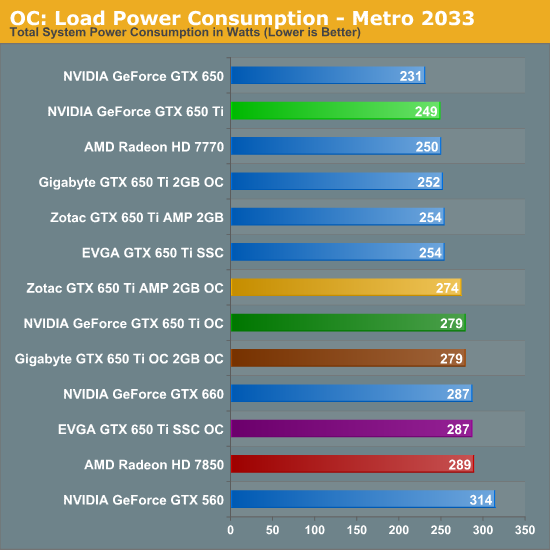
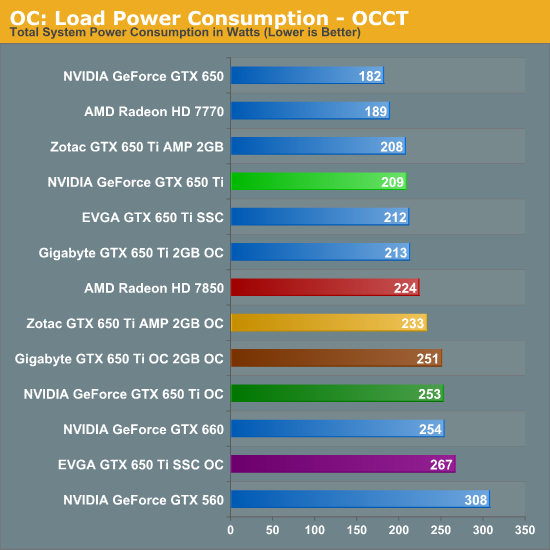
Unlike overclocking cards with GPU Boost, in the case of the GTX 650 Ti we are unquestionably overvolting the card. As a result the power consumption penalty for overclocking is quite harsh on a relative basis, though thankfully the GTX 650 Ti starts out low enough that the PCBs and the coolers are having no problem keeping up.
Overall, our overclocking efforts have pushed the power consumption of our GTX 650 Ti cards up by 30-40W, which puts power consumption just below the GTX 660 and 7850. The best performing card in this regard – that is, the card with the smallest increase in power consumption – is the Zotac card, followed by the close pairing of the Gigabyte card and the reference card, and finally EVGA’s card. This is one of those cases where a sample size of 1 just isn’t big enough, so there’s no clear reason why Zotac does so well or EVGA fares so poorly. Looking at temperatures it may be that we’re seeing temperature induced leakage, then again it may be that the hottest card is the hottest because of that power consumption.
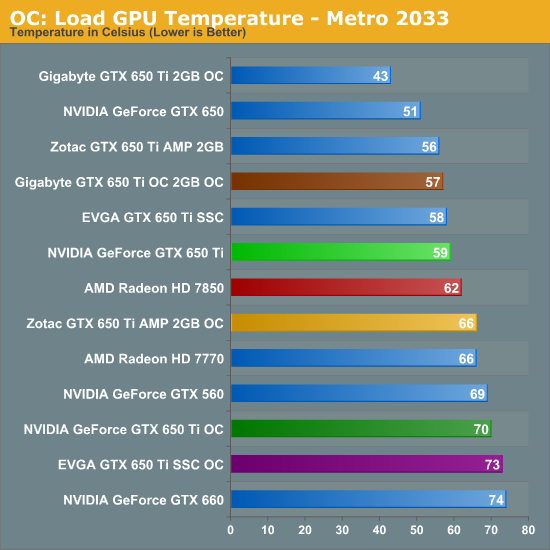
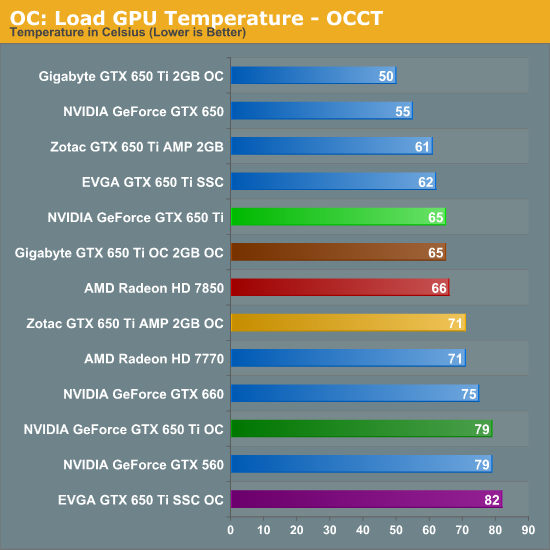
Next up is load temperatures. As we’ve already seen in our look at stock performance the Gigabyte card has a relatively aggressive fan curve, which is great for temperatures at the cost of noise. As a result even in the worst case scenario of OCCT it only hits 65C, 6C cooler than the next-closest overclocked card. That brings us to the Zotac card, which isn’t as cool as Gigabyte’s card but at 71C is still doing rather well. This is followed by the reference card at 79C, and finally the EVGA card at 82C.
Given the amount of power we’re channeling through these cards, it’s rather surprising just how well they hold up here. Even with these small coolers GPU temperatures are well into the safe zone, though the EVGA card is about as hot as we’d let such a card get under normal circumstances.
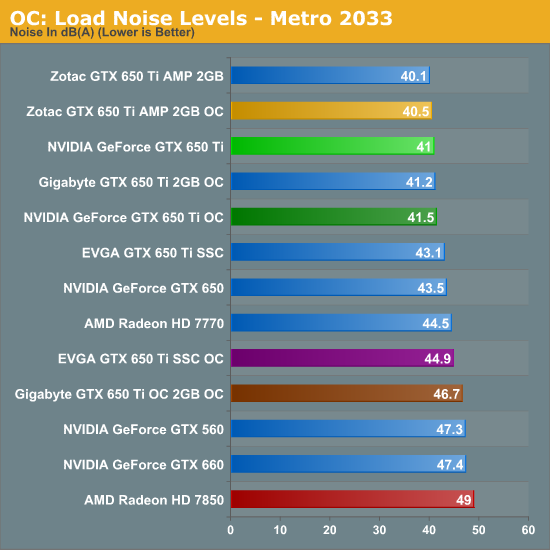
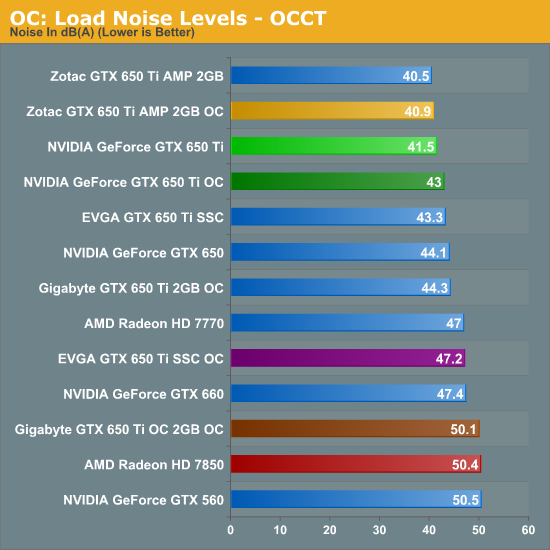
Moving on to noise, the cards that were previously doing well with stock settings continue to do well, while the rest of the cards fall further behind the leaders. The quietest card remains the Zotac, which even overvolted and running OCCT still doesn’t pass 41dB(A), which is simply incredible given the amount of power it’s pulling by this point. And as we’ve already seen its temperatures are respectable too, so Zotac seems to have hit the perfect balance here.
At the other end of the spectrum we have the EVGA and Gigabyte cards. Gigabyte continues to fall behind due to their aggressive fan curve, while the EVGA card and its poor overclocked temperatures require the card to push the fan even harder to keep up. Neither one of these cards is doing an acceptable job in light of what the Zotac card nor the reference card are achieving.










91 Comments
View All Comments
SodaAnt - Tuesday, October 9, 2012 - link
Why is it that all the manufacturers seem to have the need to put two huge fans and heatsinks on a GPU that only has a TDP of 110W? I mean, I can see having that on a GTX 680 or something, it needs it, but why bother on a low end card? You're just adding price for what is pretty much looks.Shark321 - Tuesday, October 9, 2012 - link
Chip cooling results usually in high noise, so I'm glad they put large heatsinks on the 650 Ti.Blazorthon - Tuesday, October 9, 2012 - link
The 650 Ti has some of the lowest noise and temp results of any graphics card in its class. Those large coolers are definitely beneficial, not that I wouldn't mind seeing some single slot 650 Ti models.MrSpadge - Tuesday, October 9, 2012 - link
"But as it stands today the GTX 650 Ti only makes real sense for buyers who absolutely cannot go over $149"If said buyer can't add another 20$ he probably shouldn't be spending his money on a video card at all.
TheJian - Wednesday, October 10, 2012 - link
You can say that at any price...LOL. Everyone's budget is different. The 660TI really only makes sense for someone who can't spend another $100 on a 670...And then you chime in with your comment again...Both comments are pointless. Ryan puts crap like that in to disparage NV in every article. At $149 it comes with AC3 a AAA title not even released yet, arguably the card is only $120. Unless you think you'll be able to get AC3 for the price of $30 the day it hits. I doubt it. Probably $45-60. So quite a good deal for someone wanting AC3 and only having $150 correct? Pull your head out Ryan. :) Quit making bias comments like this. It's amazing they even give you a AAA title at $150 range.If some kid's been saving his allowance for ages and finally has $150, to replace his old X card it makes total sense. Same for any adult. These cards are for people who don't have $200 etc. No point in making any comment like ryan did.
And at 1680x1050, where most of these users will run this card it doesn't lose much. He keeps quoting cards above where they should run. $100-150 cards are not for 1920x1200. You'll be turning stuff down all day, thus not giving you what the devs wanted you to play. Just like the 660TI/7950 isn't for 2560x1600 either. He keeps using this crap to bash NV cards. This is why he leaves out minimums on almost everything. If he showed those #'s you'd see you can't even play there with these. $300 is for 1920x1200, $450+ is comfortable at above this, $150 is solidly 1680x1050 when MINIMUMS are looked at with max details. If you're not running with all the goodies on, you're not running what the dev wanted you to play. You're missing the FULL experience. 2560x1600 was unplayable on 3/4 games at hardocp on 7950B/660TI. So why talk about those two in the same sentence with 2560x1600? It's DUMB. Two of the games hit 15/17fps on both cards...LOL. That's a freaking slide show FFS. He bashes NV all day over bandwidth for UNPLAYABLE SETTINGS on both cards in those cases. I'd say he doesn't get it, but he does, he knows exactly what he's doing. He loves AMD or they give him something for the love ;) I really don't care who wins at 15fps settings, and neither should ANY of us. They had games where the drop was 100 to 22-26fps on 7950 from max to min...But as long as ryan evades minimums in games he can quote AMD in a better light...LOL.
jtenorj - Wednesday, October 10, 2012 - link
I don't know if experiencing all the developer intended matters as much as simply enjoying the game. The cheapest you can get a "modern" console(not counting the wii) is like 100 bucks for a 360 with a contract for xbox live. If you already have a decent computer from the last few years with crap graphics, you can drop in a 100 dollar(or less) HD7750, overclock it some, and blow away any console's graphics at 1080p by using medium pc settings. If you up the budget a bit to the HD7770 and overclock, you could even manage high settings at 1080p with playable frame rates. If you want to see minimum frame rates, you can go to other sites like hardocp(as mentioned, though it doesn't seem like they have a review up for gtx650ti...yet). Even better is techreport for testing of individual frame times that can catch latency spikes a minimum frame rate measure might miss.justaviking - Wednesday, October 10, 2012 - link
Eventually you have to draw the line somewhere.Start with a budget of $100...
$100? Why not spend $120?
$120? Why not spend $140?
$140? Why not spend $160?
$160? Why not spend $180?
$180? Why not spend $200?
Why not spend $200? Because you started with a $100 budget.
It's not always that you "can't" spend another $20, but most people have to draw the line somewhere. For some people it's $300, others it's $150. Besides, the person spending $150 might have started with a target of $125, and has already "shopped up" to the $150 mark.
This works in the opposite direction too. Why not SAVE $20 and get a cheaper product if it has "almost" the same performance? Then why not save another $20, and so on? Soon you'll be hopelessly underpowered.
That's the sweet agony of shopping for parts like this. There is such a spectrum of price/performance options that you are always near a 2nd or 3rd option. If there was simply one AMD card and one Nvidia card at $100-200-300-400-500 price points, it sure would be a lot easier to go shopping. But what would be the sport in that?
johnsonjohnson - Tuesday, October 9, 2012 - link
Looks like it's gonna have to be the 7850 then. Time to finally retire that 4830...EnzoFX - Tuesday, October 9, 2012 - link
Sorry if I missed it, but this is often not discussed. This is something I cannot stand in lower end cards. Fixed speed fans. They are annoying usually. Then again, I usually swap out the cooler. I'm otherwise all for shorter cards.Ryan Smith - Wednesday, October 10, 2012 - link
Yes, it has variable fan speeds. In fact none of the GeForce 600 cards we've reviewed (including the 640) have a fixed fan speed.